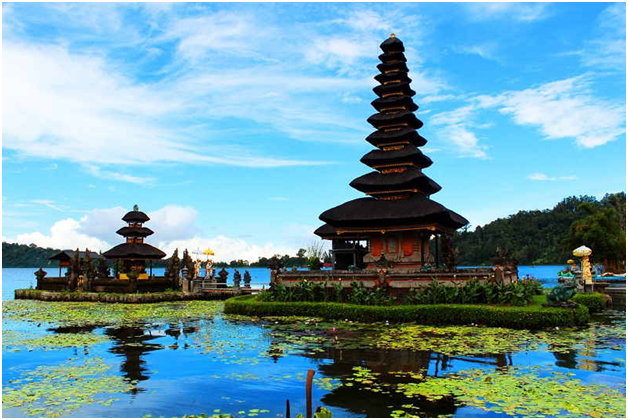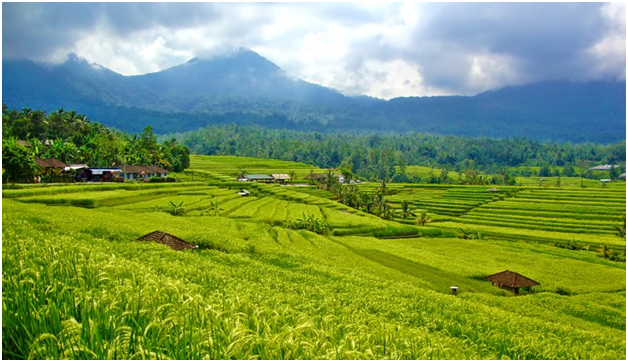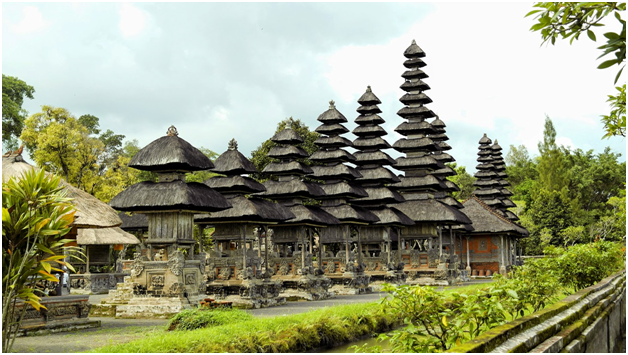Pick Up 08.00-08.30am, Price $100/Car/2 Persons
Visit:
• Munduk : The Longest Waterfall In Bali
• Buyan & Tamblingan : Beautiful Twin Lake
• Bedugul : Temple On The Lake
• Candi Kuning : The Biggest Vegetable & Fruit Market
• Jatiluwih : The Biggest Rice Terrace In the World
• Taman Ayun : Royal Family Temple
Note: The price is including all entrances ticket, 1x Lunch (Buffet Indonesian Food), Mineral Water, Soft Drink (Coke or Spite or Fanta) Car, Petrol, Parking, English Speaking Driver, Balinese dress to the temple (Sarong), Chilled Towel, & 21% Government tax.
1. Munduk Waterfall: Munduk Waterfalls are among Bali’s most scenic, located within Bali’s lush and forested central-northern highland region. The falls are a highlight feature of the namesake village of Munduk in Buleleng, North Bali, reachable after a 300m walk from the main road on which trekkers can enjoy soothing nature sights and sounds along a forest route. Only a short trek north from Munduk is Waterfall, which offers similar features.
Cool mists and the rushing sound of water greet you upon reaching the Munduk waterfall. Here you can wade into the rocky pool for a cold dip. A further (often dirt to slightly muddy) trek towards the Melanting waterfall leads you through a lush forest with rivers and nature calls before a bridge that actually traverses over the fall’s peak. Definitely for nature lovers, it’s all about venturing into Bali’s ‘wilde side’ and these two falls serving as your prize.
At an altitude of approximately 850m above sea level, the Munduk and Waterfalls neighbor local clove and coffee plantations that is also a sightseeing feature of this region. A famous plantation and resort here with luxury accommodation is the Munduk Moding Plantation, only half a kilometer southwest from the falls site. The best time to go on nature treks here is June to August, when it’s not too hot or drizzly.

2. Buyan & Tamblingan: Lake Buyan and Lake Tamblingan, separated by a rainforest-covered hill, are known as the Twin Lakes. This sight is a great overview of the volcanic heart of Bali. Volcanoes have created and shaped this island, creating volcanic cones and lakes, and producing rich soils enabling a lush forest to grow. Lake Buyan (on the left here) is Bali’s second biggest lake, after Lake Batur. Coming from the southern developed areas of Ubud, Sanur, Denpasar or Kuta, here we realize what Bali really is about. Grand Nature, like about the whole Indonesian Archipelago. It was a choice of the authorities to dedicate the south of the island to cities and large scale tourism, and leave the rest of the island less urbanized. This stop over the Twin Lakes is often part a tour in the northern part of Bali.
3. Bedugul Temple on the Lake : Bedugul is the name of both a small city and a mountain-lake resort area, which Balinese have long used for weekend retreats. Bedugul is an excellent base for walking trips around the lakes and surrounding hills. Bedugul is located in a high plateau at the center of the Island. Cool air and mists are natural for the place. Bedugul is a resort in Beratan Mountains,Beratan Lake and also the Ulun Danu.
Bedugul is a favorite place for Balinese family for weekend picnic. Bedugul is also a center of horticulture. We’ll find plenty of fruits and vegetables here. Here we find 3 of Bali 4 lakes, Bratan, Buyan, and Tamblingan. Bratan, the largest of the three is perfect place for water sports such as para sailing, motor boating, jet skiing, water skiing, canoeing, etc. Bedugul fertile soil also produced abundance of plants and trees, some of them formed rain forests with their exotic birds, monkeys, and other creatures.
4. Candi Kuning Fruit & Vegetable Market: When on holidays in Bedugul, we should not skip visiting a traditional fruit and vegetable market in Candi kuning village, the market is located next to the big corn statue in the direction to Bali Botanical Garden and Lake Bratan.
Bedugul market offers plenty of fresh vegetables, fruits, and ornamental plants. Lines of shops and kiosks sell sub-tropical vegetables that grown only in places with cool and fresh climate like Bedugul. We can find a lot of tropical fruits like papaya, banana, rambutan, mangosteen, strawberry and many others.
The large variety of spices such as cloves, nutmeg, pepper, and turmeric also could be found here. And for those who love ornamental plants, Bedugul market offers many orchids, foliage plants, roses, hibiscus, and begionas.

5. Jatiluwih Rice Terrace: Bali Jatiluwih Rice Terrace is a favorite tourist destination in Bali famous with the beautiful rice terrace unfolding from the foot of mountain until the coastal side. It is one of places to visit in Bali with the beautiful view as according to its name from Jati and luwih, where Jati mean really and Luwih meaning especial, good, and beautiful or the equivalent. The local paddies are planted in this place look typically of the high relative size plant if it is compared with other pre-eminent paddy planted by most farmers in Bali. Despitefully, Jatiluwih also famous with its organic agriculture system due to the location is located in the in the plateau of Watukaru Mount which is suitable for the agriculture development.
Jatiluwih is one of the places of interest in the area of Penebel, Tabanan. Jatiluwih famous for its natural beauty with terraced rice fields which neatly. in this place also in the beautiful mountain scenery named Batukaru mountain, because the location of this Jatiluwih right at the foot of the Batukaru mountain.
Jatiluwih rice cultivation has an area of approximately 636 ha. And this Jatiluwih rice field located at an altitude of 700 meters above sea level. This area is a suitable place to visit for the one who missed the Mountain fresh air and the natural panorama as a place to soothe the mind, because of the beautiful place that is still natural with fresh air.Jatiluwih is surrounded by cool atmosphere because it is located in the height of 700 meters above sea level. Besides its nature potency, Jatiluwih is also saving the cultural potency, especially history of the Petali Temple existence that is related to the power of Ida Dalem Waturenggong King in Keraton Gelgel (1460 – 1552). The distance from Denpasar to Jatiluwih is about 48 km and it is situated in upstate of Tabanan town (28 Km). The road to this place has been progressively improved so that motor vehicle can enter from east side through Pacung Village and go to Jatiluwih and also from the west side from Watukaru Temple pass to Jatiluwih. Jatiluwih is many visited by tourist from local and foreign countries who want to enjoy the cold atmosphere and beautiful panorama of rice terrace. Jatiluwih as a nature tourist destination in Bali which has been recognized since Dutch colonial build the Security Headquarter and until now the local residents conceives with the Dutch Tangs. Indonesian government has assigned the Jatiluwih to be a Tourist Destination Village because of this potency.
Jatiluwih also keep the unique religious ceremony attraction which is famous know as Patirtaan in Petali Temple on Wednesday Kliwon Ugu (Based on Balinese Calendar). The local residents believe that Petali Temple is a worship center of The Hyang Widhi Wasa (the God) as agriculture power. Beside of Petali Temple, there is also Pucak Rsi Temple is located in this area. As a tourist object, Jatiluwih provides the public facilities like parking area, toilet, resting bale and Wantilan for tourist who is enjoying the beautiful panorama. Some restaurants have been built to serve the food and beverage. And you can enjoy your Buffet INDONESIAN Foods (Lunch Time)
6. Taman Ayun Royal Family Temple: Bali Taman Ayun Temple is situated in Mengwi Village of Badung District, around 18 km to the west of Denpasar. It is a very beautiful temple, as the name tells (Taman Ayun means temple in a beautiful garden). In addition to its beauty, Taman Ayun Temple is also considered to have historical values, which makes the regional government of Bali suggests the UNESCO in 2002 that this temple is included in World Heritage List.
Taman Ayun Temple is a Mother Temple (Paibon) to Mengwi Kingdom. This temple was built by Mengwi King, I Gusti Agung Putu, in the Javanese year of 1556 (1634 AD). Initially, I Gusti Agung Putu built a temple to the north of Mengwi village to the worship of his ancestors. The temple was named Genter Park. When Mengwi grew into a big kingdom, I Gusti Agung Putu moved Genter Park eastward and expands the compound. The expanded temple was officially declared Taman Ayun Temple on Kliwon Tuesday – Medangsia the fourth month in the Javanese year of 1556. Until today, each Kliwon Tuesday of wuku Medangsia in Javanese calendar (Saka), a piodalan (ceremony) is held in this temple to celebrate the temple’s anniversary.
Taman Ayun Temple has gone through a number of restoration works. Large scale restoration was implemented in 1937. In 1949, restoration work was done to the kori agung (the grand room), Bentar temple. A big wantilan was also constructed during the time. The third restoration was implemented in 1972, followed by the final restoration in 1976. Taman Ayun Temple complex is 100 meters in length and 250 meters in width. The complex comprises an outer court and three inner courts. The inner courts, sided with stone fences, have different elevations, and the inner most is the highest one. 
The outer court Taman Ayun Temple, also known as Jaba, is situated at the outer side of the pool. There is a bridge over the pool to connect the outer court to the inner ones. At the end of the bridge, on the inner court side, there is a Bentar gate followed by a pathway leading to the inner courts. There are two giant statues at each end of the bridge.
At the left side of the pathway Taman Ayun Temple, near the gate, there is some sort of a small guardhouse. Here, at the first inner court, there is a Wantilan (a sort of hall) at which some ceremonies usually take place, including a cockfight, which is also part the ritual ceremonies at the temple. There is a pathway lying across the first inner court and dividing it into two parts, connecting the gate into the first inner court to the one into the second inner court. To the southwest, there is a round gazebo at which one can have a rest and enjoy the beauty of the temple. There is a pond near the gazebo covered with water lilies. Right at the center of the pond, there is a small post that sprinkles water to nine different directions. To the east, there is a cluster of small temples called Luhuring Purnama Temples.
There is a gate at the end of the pathway Taman Ayun Temple dividing the first inner court into two. The gate leads to the second inner court, which is situated on a higher ground than the first one. Across from the gate, on the second inner court, there is a building functioning as a partition. The partition Taman Ayun Temple decorated with relief sculpture depicting nine guardian gods of compass points.
To the east, there is a small temple called Dalem Bekak Temple. To the west, around the corner, there is a balai Kulkul with its roof rising high. The third inner court, which is also the inner most and the highest one, is the most sacred area. Its main door, which is called pintu gelung, is placed right in the middle and it is opened only during ceremonies. The main door, however,Taman Ayun Temple is flanked by two gates through which people can access the court to do daily routines at Taman Ayun Temple. The court houses several Merus, a temple, a Gedong, a Padmasana, a Padma Rong Telu, and other religious buildings.

